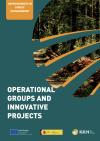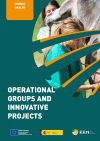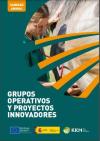Media library
Documentary, graphic and/or audiovisual knowledge objects are offered here, offering information on various sectors and topics. Use the keyword search or search filters to access current audiovisual and documentary knowledge objects useful for your implementation.
If you have any questions or suggestions, please contact us here.
Avian Influenza Biosecurity Standards
Basic biosecurity standards for the prevention of avian influenza
Surveillance and control program for Salmonella serotypes of public health importance in poultry farms in Andalusia
Salmonellosis is a disease of humans and animals caused by microorganisms of the Salmonella genus belonging to the Enterobacteriaceae family. This family is composed of many serotypes. Not all serotypes are important in animal health, as some do not cause disease in animals. However, they are important in public health because they are the cause of one of the main foodborne illnesses.
Newcastle Disease Surveillance Program in Domestic Poultry 2024
Newcastle disease virus (NDV) belongs to the Paramyxoviridae family in the Avulavirus genus. There are ten avian paramyxovirus serotypes designated APMV-1 to APMV-10, and the Newcastle disease virus has been designated APMV-1.
Avian Influence Surveillance Program in Domestic Poultry
Avian influenza (AI) is a highly contagious and extremely variable infection of poultry and wild birds, the latter acting as a natural reservoir. Disease can range from moderate to severe, but only the H5 or H7 subtypes cause Highly Pathogenic Avian Influenza (HPAI), the most severe strain. These are extremely contagious and virulent strains, causing high mortality in poultry.
Avian flu: information brochure
Avian influenza (bird flu) is a disease caused by a virus that can affect most birds, both domestic and wild. This virus can also cause illness in humans. In 2003, an outbreak began in Southeast Asia and has gradually spread to other parts of that continent, as well as to Europe and Africa.
Contingency plan for suspected and confirmed sheep and goat pox in Andalusia
Sheep and goat pox is an infectious disease caused by a DNA virus belonging to the Capripoxvirus genus within the Poxviridae family. It produces a clinical picture in sheep and goats characterized by the appearance of fever, generalized nodules and papules, rarely vesicles, internal lesions particularly in the lungs, and, ultimately, death.
Manual on national plans for the eradication of animal diseases in Andalusia
Manual for the eradication of ruminant diseases
Caprine tuberculosis control program
Tuberculosis is a chronic, contagious, infectious disease that suppresses the immune system, leading to the onset of other illnesses, loss of production, and trade restrictions, including restrictions on participation in auctions and competitions. It affects all domestic animals, some wild animals, and humans, and is therefore classified as a zoonosis.
Results of surveillance of transmissible spongiform encephalopathies
Bovine spongiform encephalopathy (BSE, colloquially known as "mad cow disease") is one of the transmissible spongiform encephalopathies (TSE) that affects cattle. Like other TSE diseases, it is characterized by the degeneration of brain tissue, which takes on a sponge-like appearance, leading to death.
National Program for Surveillance and Control of Ovine and Goat Brucellosis in Andalusia.
Member States are primarily responsible for the eradication of ovine and caprine brucellosis. Therefore, the main objective is to declare regions or provinces officially free of brucellosis by Community Decision if they meet the criteria established in Delegated Regulation (EU) 2020/689, consisting of the absence of confirmed cases of B. abortus, B. melitensis, or B.
National Program for Surveillance and Control of Ovine and Goat Brucellosis 2023-2030. (Infection with B. abortus, B. melitensis, and B. suis)
Member States are primarily responsible for the eradication of ovine and caprine brucellosis. For a zone to be declared officially free from the disease, it must meet the following requirements: no confirmed cases of B. abortus, B. melitensis, or B.

Livestock Breeding. Operational Groups And Innovative Projects
English translation of a compilation of projects developed through the regional and national Rural Development Programmes, operational groups and innovative projects that are working on livestock breeding.

Animal Health. Operational Groups And Innovative Projects
English translation of a compilation of projects developed through regional and national Rural Development Programmes, operational groups and innovative projects that are working on animal health issues.

Animal Health. Operational Groups and Innovative Projects
This publication is a compilation of Operational Groups and Innovative Projects in animal health in Spain.
Dossier of supra-autonomous innovation projects
Inventory of innovative projects implemented by supra-regional operational groups of the European Innovation Partnership for agricultural productivity and sustainability of the National Rural Development Programme (PNDR) 2014-2022, submeasure 16.2.
Grups operatius a Catalunya. Call 2018 (Catalan)
The Technical Dossier no. 123: “Grups operatius a Catalunya. Call 2018” is dedicated to the Groups Operatius developed within the framework of the CAP Strategic Plan (PEPAC 2023-2027), and includes the Agricultural Knowledge and Innovation Systems, also linked to AKIS (Agricultural Knowledge and Innovation System).
Operational Groups in Catalonia. Call for 2018
"Technical Dossier No. 123: “Operational groups in Catalonia. Call 2018” is dedicated to the Operational Groups developed within the framework of the CAP Strategic Plan (PEPAC 2023-2027), and taking into account the Agricultural Knowledge and Innovation Systems, also known as AKIS (Agricultural Knowledge and Innovation System).
Report on Spanish supra-autonomous EIP-AGRI projects 2017-2022
The report summarizes the first funding period (2014-2022) of the European Innovation Partnership for Agricultural Productivity and Sustainability (EIP-Agri) operational groups, implemented at supra-autonomous level in Spain.





